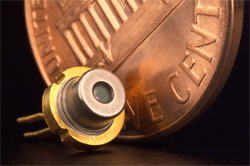Landmarks: Invention of the CD-Player Laser
Focus Landmarks feature important papers from the archives of the Physical Review. During 2010, the 50th anniversary of the invention of the laser, we’re highlighting some laser-related papers, as part of LaserFest.
The invention of the semiconductor laser took lasers from the scientist’s lab and action hero’s arsenal to every living room DVD player and grocery store scanner. It began with the serendipitous discovery in 1962 that gallium arsenide could be made to produce surprisingly intense light. Later that year, the first gallium arsenide laser was reported in Physical Review Letters. The modern descendants of that device are the tiny lasers that abound in countless modern appliances.
Following the 1948 invention of the transistor [see Focus, 15 May 2009], semiconductor technology–mainly with silicon and germanium–developed rapidly. Eventually some researchers began using gallium arsenide (GaAs) to make certain specialized kinds of diodes, components that let current flow in only one direction.
A diode works by combining two types of material. Depending on what elements are added to it, a semiconductor can be either n-type, meaning that current flows in the form of electrons, or p-type, which carries current as “holes”–positively-charged vacancies corresponding to missing electrons. A diode has a two-layered structure with an internal p-n boundary. Applying a positive voltage to the n-type layer pulls electrons and holes in opposite directions, away from the p-n boundary, and no current flows. A “forward” voltage, with the opposite polarity, draws both types of carrier into the boundary region, and the diode then conducts current.
At a conference in the summer of 1962, researchers reported successful demonstration of GaAs diodes, but with a remarkable twist: the diodes emitted prodigious quantities of infrared light. The phenomenon of electroluminescence from semiconductors was not new, but the intensity of emission from GaAs diodes was a surprise to the meeting participants. It corresponded to a conversion efficiency from electric to radiative energy approaching 100 percent. Physicists at the time understood that electrons and holes combining at the p-n boundary could release photons, but they didn’t know why a GaAs diode emitted so much light; silicon and germanium diodes released none at all.
Nevertheless, with the 1960 invention of the laser fresh in their minds [see Focus 27 Jan 2005], several researchers saw that light emission from a diode junction could potentially be the foundation of a new kind of laser. From a quantum mechanical perspective, they reasoned, merging of electrons and holes could be “stimulated” by the presence of radiation of the correct frequency, leading to a cascade of coherent emission, just as in a conventional laser.
The goal was first achieved by Robert Hall and his colleagues at the General Electric Research Laboratory in Schenectady, New York. They turned a roughly cubic GaAs diode, 0.44 millimeters on a side, into a laser by polishing two of the opposing faces to make an optical cavity in which light reflected back and forth through the crystal. The reflecting light stimulated further emission from the electron-hole pairs in the boundary layer. Hall had the idea of polishing the crystal because, as a child, he had polished glass to make his own telescope, says Russell Dupuis of the Georgia Institute of Technology in Atlanta.
In their Physical Review Letters report of 1 November 1962, Hall and his colleagues surmised that light-emission in GaAs occurs because the electrons and holes occupy quantum states that allow them to produce only photons when they combine. In silicon and germanium, by contrast, a momentum mismatch between electron and hole states forces them to produce phonons, or quantized lattice vibrations, that carry off the excess momentum along with the energy. This picture was essentially correct, as theorists later showed. Light-emitting diodes (LEDs) also radiate by electron-hole merging, but they are constructed without the optical cavity needed for lasing.
Two other groups followed quickly with their own GaAs lasers [1]. A few weeks later, Nicholas Holonyak and his colleagues at General Electric in Syracuse, New York, made a laser with gallium arsenide phosphide, an alloy, that emitted visible red rather than infrared light [2]. This first successful use of a semiconducting alloy, rather than a pure compound, was of huge significance in opening up a new realm of semiconducting materials with a wide variety of desirable properties, says Dupuis.
–David Lindley
David Lindley is a freelance science writer, now retired. His most recent book is The Dream Universe: How Fundamental Physics Lost Its Way (Penguin Random House, 2020).
References
- M. I. Nathan, W. P. Dumke, G. Burns, F. H. Dill, Jr., and G. Lasher, “Stimulated Emission of Radiation from GaAs p-n Junctions,” Appl. Phys. Lett. 1, 62 (1962); T. M. Quist, R. H. Rediker, R. J. Keyes, W. E. Krag, B. Lax, A. L. McWhorter, and H. J. Zeiger, “Semiconductor Maser of GaAs,” Appl. Phys. Lett. 1, 91 (1962)
- N. Holonyak, Jr., and S. F. Bevacqua, “Coherent (Visible) Light Emission from Ga(As1-xPx) Junctions,” Appl. Phys. Lett. 1, 82 (1962)
More Information
Invention of the Maser and Laser (Focus 2005)
Birth of Modern Electronics (Focus 2009)
Russell D. Dupuis, The Diode Laser–the First Thirty Days Forty Years Ago, LEOS (IEEE), 2003
PRL Milestones write-up by Martin Blume





